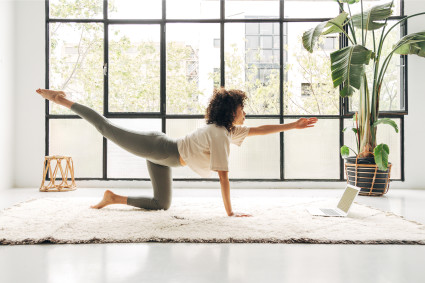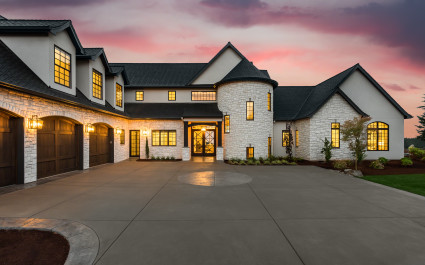What is a zen room?
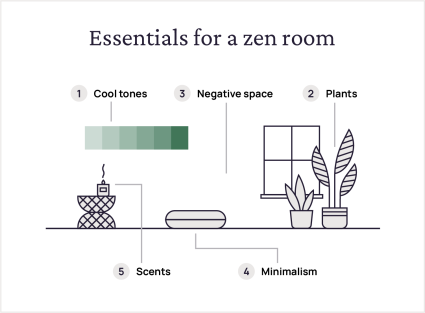
Benefits of a meditation space
A meditation room or zen room is a perfect place to enjoy some solitude. It can be a sacred space for relaxation, de-stressing, or simply introducing greater feelings of rejuvenation. This relaxing room can be an ideal location for reconnecting with self-care practices.What is needed for a zen room?
Since the overarching goal of a zen room is to encourage peacefulness, minimizing distractions is a recurring theme. That still leaves plenty of room for personalization, which is partially responsible for zen rooms' growing popularity. Inspiring meditation room ideas include:Cool tones
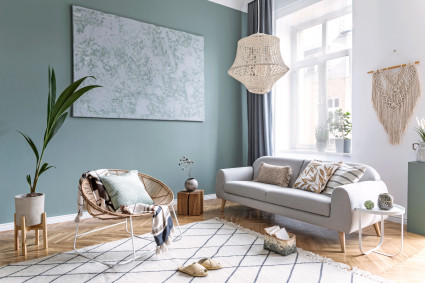
Minimalism
Leaving distractions at the door is an important step toward relaxation. With this in mind, keep things simple when designing your zen room. Avoid decorating your relaxing space with too many trinkets or pictures. Prioritize only having items in the room that will nurture your mental well-being.Natural light
Abundant natural light can increase feelings of calm in your meditation space. Choose a room with ample windows where you can avoid the need for artificial light during the daytime hours. East or west-facing windows may allow for sunrise or sunset views in your sacred space. Even better, consider creating your meditation space outdoors.Luxury second homes with views
See allNegative space
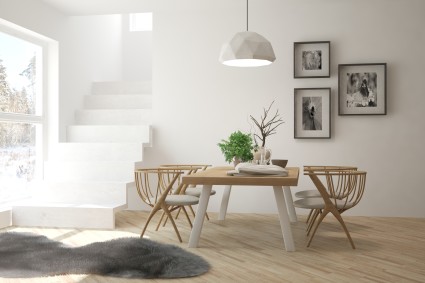
Plants
Spending time in nature is linked to reducing negative feelings like stress while increasing positive ones. Bringing natural elements like plants into your meditation room can be a great way to bring out those positive emotions.Scents
Aromatherapy can be used to induce relaxation. This can take the form of incense, candles or essential oil diffusers. Stay away from scents that are very strong — especially if you are in a small space — as they can get irritating over prolonged periods in your meditation space.According to Lily Wili, CEO of Ever Wallpaper, “Scents such as lavender and jasmine are ideal for creating a calm environment. You’ll instantly get a feeling of peacefulness when you enter a room that smells and looks good. Additionally, it’ll help you focus as you prepare to meditate and let go of negative emotions.”7 inspiring meditation room ideas for every personality

- Strategists (INTJ, INTP, ENTJ, ENTP): If you have an analytical mindset and prefer working independently, then this could be you. Strategists tend to be introverts who value logic and order. They have high expectations and often pursue perfection.
- Creatives (INFJ, INFP, ENFJ, ENFP): If you are an enthusiastic soul with a passion for the arts, then you might be a creative. These personality types are idealistic and charitable. They are tirelessly optimistic and often make inspiring leaders.
- Practical dwellers (ISTJ, ISFJ, ESTJ, ESFJ): Practical dwellers like to keep facts at the forefront of their minds. They are incredibly caring and like to use their skills to protect their loved ones. They make effective managers and are very reliable.
- Free spirits (ISTP, ISFP, ESTP, ESFP): Free spirits mix creativity with practical goals. They’re tinkerers and explorers. Plans often get pushed to the wayside in favor of spontaneous ideas.
1. Meditation room
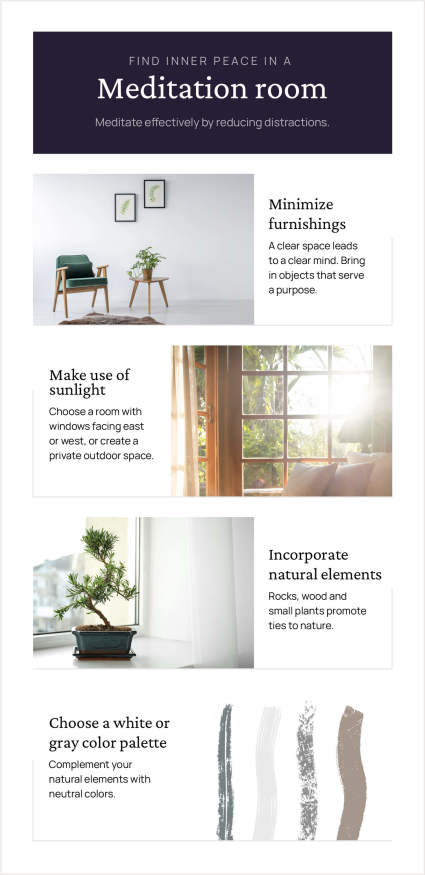
Great for: Strategists
A meditation room is the classic zen room. Its primary purpose is to center oneself to increase mental peace. A dedicated meditation room can even have physical benefits, like reducing the wake time of insomniacs by 50%. Strive to keep distractions to an absolute minimum. Objects that don’t directly aid your focus should be left in other areas of your home. If possible, select a room that gets plenty of natural light. A sheer fabric can be used as a window shade to diffuse intense light. Since meditation rooms do not require many objects or a large area, sometimes it isn’t necessary to use an entire room. You can design a meditation corner that takes up minimal space while still providing peacefulness. “Regardless of how devoted you are to mindful meditation, the space that is created for sitting (zazen) is important,” says Anne-Marie Emanuelli, creative director of Mindful Frontiers, a mindful meditation coach. “Whether it is a corner in the bedroom with just a pillow and mat or a separate room in the house with an altar, music, incense, and lots of pillows, feeling comfortable in the space will become the container of your meditation practice. It will be where you want to go for a few minutes or hours of calm and mental space.”Meditation room ideas:
- Minimal furnishings: Give yourself space to wander
- Plenty of sunlight: Natural light helps you relax
- Natural elements: Take design inspiration from the outdoors
- Neutral colors: Keep a muted color palette
- Zen decor: Incense or scented candles, tranquil instrumental music, a rug and meditation cushion
- Textures: Wood and stone
2. Music room

Great for: Creatives and free spirits
Music can give a profound boost to your mood and reduce anxiety, helping you manage stress and even cope with physical pain. If music is a constant in your life, harnessing it in your zen room can have lasting benefits for you. Bring your music collection or instrument into the room — whether you already play one or want to learn. Having a private space to express yourself, free from scrutiny, could not be more important. This is one zen room idea where it is fine to bring in extra knickknacks if they bring you joy. A poster from a concert you went to or your favorite band’s merch is all fair game. It’s all about surrounding yourself with things that elicit positive emotional feelings.Music room ideas:
- Zen decor: Sound system, records/CDs, instruments, rugs or carpet
- Texture: Vinyl
- Color palette: Tan or black and white
3. Reading room
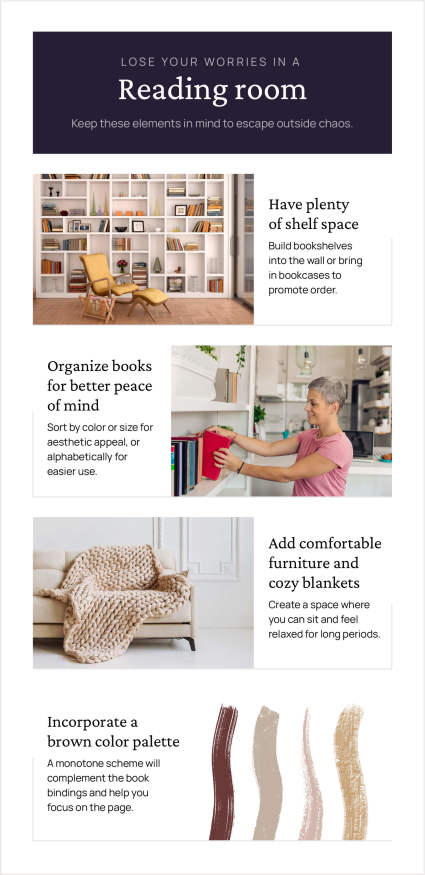
Great for: Creatives and strategists
The principles behind a reading room are very similar to a music room. Surrounding yourself with books that you are fond of or look forward to reading can bring out comforting feelings similar to a favorite album. Reading can bring down your cortisol levels — a hormone related to stress. The number of books you keep in this relaxing space is limited only by the available shelving. Keep your books organized to avoid feelings of claustrophobia and disarray. If the room is in order, your mind will be less likely to wander from the words on the page.Try sorting books by size or color to discover which produces more calming decor. Get a comfortable chair or couch that you can spend hours in.Reading room ideas:
- Shelf space: Allow plenty of room for your books
- Organization: Minimize visual clutter by organizing books by color or size
- Zen decor: Give a cozy feel with built-in bookshelves, heavy blankets and parquet flooring
- Texture: Wood and leather
- Color palette: Brown
4. Hobby room
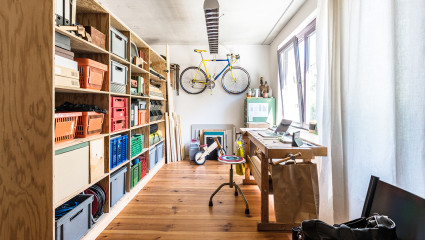
Great for: Free spirits and practical dwellers
Sometimes the best way to find inner peace is through actively doing what you enjoy. People who do things they enjoy benefit from lower blood pressure and better moods. Dedicating a spiritual room to your hobbies can help pair the two and lead to constructive mental and physical growth. Your hobby room can incorporate woodworking, painting or puzzling — basically anything you want.Adorn your walls with the tools you use. Display completed projects that you’re proud of. Even enjoyable hobbies can lead to stress when things aren’t going right. By decorating with reminders of past successes, you can recenter yourself more easily and get the rewards of a zen room. The greatest hindrance to a hobby room is clutter. Cleaning the space after every session will help you get into a flow more quickly each day.Hobby room ideas:
- Natural light: Ample lighting for crafting or tinkering
- Zen decor: Tools or equipment, countertop space and storage bins
- Texture: Wood
- Color palette: Tan
5. Green room

Great for: Practical dwellers
While most zen styles incorporate natural elements, green rooms take it to the extreme. Cover your floors and walls with plants to fill the space with green leaves and the colors of blooming flowers. Incorporate furniture that’s practical but doesn’t overwhelm the space. Chairs and couches with low backs can make room for plants to hang low and envelop you in a forest of your creation. The aesthetic quality of the plants is only part of the appeal of this room. The act of caring for the plants day to day is where you will find even more benefits.Surrounding yourself with houseplants can help clean the air in the room and promote physical healing. If you find it difficult to meditate because your mind is distracted by stressors, watering and pruning each plant can give you something to focus on.Green room ideas:
- Small furniture pieces: Allow plants to be the focal point
- Elevated plants: Hang green plants from the ceiling for an immersive feel in this sacred space
- Carefully selected plants: Choose plants that match your lifestyle in terms of effort
- Zen decor: Potted plants, hangers, small furniture
- Texture: Wood and bamboo
- Color palette: White and neutral colors (keep walls and floors a neutral color to let the plants take center stage)
6. Yoga room
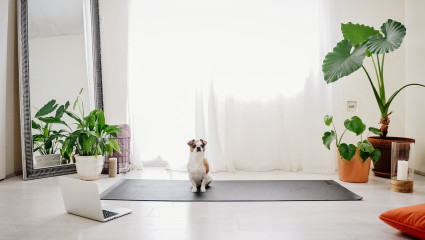
Great for: Creatives and free spirits
The meditative nature of yoga makes it easily integrate with the concept of a zen area or minimalist meditation room. While yoga can lower stress levels, it also can improve your physical health overall. The zen decor of a yoga room can be similar to a meditation room, as it also uses minimalist zen interior design elements. Since you won’t want many objects hindering your movements, optimize negative space in the room. Keep objects tight against the wall so that you’ll have free range of motion.Mirrors can be helpful when working on your form, but they can be a distraction when trying to focus. Having the option to draw curtains over the mirrors can increase the functionality of the room as a whole. “For yoga or somatic therapy, anything that requires movement, keeping furniture to a minimum and allowing open space to practice is key,” says Eva Prettyman, principal designer of Lincoln Home and Design, a home design firm. “Incorporating artwork that encourages the state of mind you are hoping to reach, or that have symbols that are wellness-related, can be helpful.”Yoga room ideas:
- Zen decor: Resin or laminate flooring, incense, a mirror and relevant artwork
- Lighting: Plenty of natural light
- Texture: Stone
- Color palette: Blue
7. Weight room

Great for: Strategists and practical dwellers
A strenuous activity like weight lifting may seem like the opposite of “zen” to some people, but it’s all about your mindset. Exercise can release endorphins that make you feel good and help you let go of the day’s irritations. Workout rooms help you find your zen by serving as an emotional escape room. Leave daily worries at the door and focus solely on reaching new personal bests. The regimented structure of workout routines can bring order to the chaotic structures of daily life. It’s important to find a balance between the cold practicality of normal weight rooms and the coziness of a zen room. Keep weights and workout accessories well organized to prevent chaos from spilling in. Use ambient sounds like trickling water to drown out distracting noise.Weight room ideas:
- Zen decor: Resin or laminate flooring, mini fountain and a mirror
- Music: Portable speaker for inspiring songs
- Texture: Metal
- Color palette: Gray
How to create a meditation room when you don’t have a lot of space

- Find a quiet corner: Aim to find a space that’s “off the beaten path” of your home where you’re more likely to be undisturbed.
- Focus on a few key decor items: Decorate your meditation space with a handful of items that make you feel the calmest, whether that’s a cozy blanket, a scented candle or a lush houseplant.
- Make it portable: Take your meditation space on the go! Gather a few of your favorite meditation room decor items and keep them in a basket. Then, if your available space changes, you can pick up and create your own space anywhere — in a bedroom that’s not being used, in your home office or in the backyard on a sunny day.

